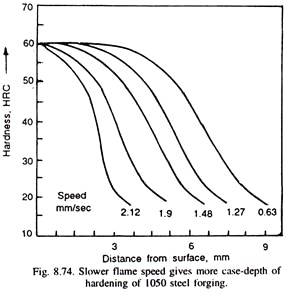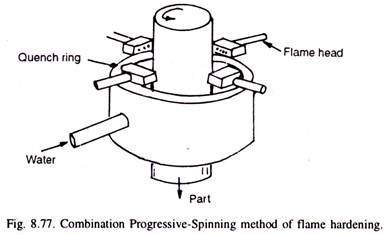In this article we will discuss about:- 1. Introduction to Flame-Hardening 2. Methods of Flame-Hardening 3. Operating Variables 4. Gases Used 5. Steels for Flame-Hardening 6. Applications 7. Advantages and Disadvantages.
Contents:
- Introduction to Flame-Hardening
- Methods of Flame-Hardening
- Operating Variables for Flame-Hardening
- Gases Used for Flame-Hardening
- Steels for Flame-Hardening
- Applications of Flame-Hardening
- Advantages and Disadvantages of Flame-Hardening
1. Introduction to Flame-Hardening:
ADVERTISEMENTS:
It is a surface-hardening process in which a thin surface section of a component of hardenable steel is heated rapidly by direct application of high temperature flame to a temperature above its upper critical temperature (i.e., it is austenitised), and then the component is quickly quenched in water or oil, transforming austenite to martensite, while core remains in original soft state, normally consisting of ferrite-pearlite structure.
The high temperature flame is obtained by the combustion of a fuel gas with oxygen or air. There is no change in composition of the steel and therefore, the flame- hardened steel (as in induction-hardening) must have adequate carbon content for the desired surface hardness (i.e., must be a hardenable steel). The hardened depth could be between 0.8 to 6 mm, or even more, depending on the fuel gas, air or oxygen, design of flame head, duration of heating, hardenability of steel, quenching medium and method of quenching.
The rate of heating and the conduction of heat into the interior appear to be more important in establishing case depth than having a steel of high hardenability. Fig. 8.74 illustrates the hardness gradients obtained by various rates of flame travel across a 1050 steel forging. It is apparent, slower the rate of travel, the greater the heat penetration, and the depth of hardening. Larger rolls have case depths up to 13 mm.
The main aim of flame-hardening is to obtain a high hardness and wear resistance of the surface, without effecting the reasonable toughness of unhardened core. It also improves fatigue, bending and torsional strength.
ADVERTISEMENTS:
2. Methods of Flame-Hardening:
The method of flame-hardening depends on the shape, size, composition of the component, area to be hardened, depth of hardened-case desired, number of components to be hardened.
ADVERTISEMENTS:
The methods are:
1. Manual Hardening:
In this method, the local heating of selected area is done by hand with a welding torch, or a suitable flame head to the hardening temperature, and is then quenched in water or oil. The flame head could be either a single orifice, or a multiple orifice depending on the area to head, uniform temperature can be ensured over the entire surface to be hardened A spray quench may be used for hardening.
2. Spinning Method:
ADVERTISEMENTS:
This method is suitable for components having rotational symmetry-round or even semi-round components such as wheels, cams, and gears. The component is put on a horizontal rotating table (Fig. 8.75 a), or put on a lathe with vertical rotation (Fig. 8.75 c), or one or more water cooled rotating flame heads (Fig. 8.75 b) equal to the width of the surface to be heated are used. For case illustrated in Fig. 8.75 c (i), there could be two methods.
In the first method, the component rotates at a slow peripheral speed of about 2 mm per second. Oxy-acetylene flame head having width equal to the whole area is used to heat which then, is immediately quenched, i.e., whole area is hardened in only one revolution. In this method, a soft band several millimeter wide at the junction of two bands hardened first and the last forms.
The second method avoids this draw back where the whole surface of the component is heated uniformly by rapidly rotating the component, and then quench whole of it quickly. This method consumes more gases.
ADVERTISEMENTS:
The spindle is rotated with 1 revolution per second and heating may take several minutes. Gears with modules up to 5 can be thus, spin hardened. The quenching may be done by sprays from all sides, or by immersing in a quench tank. A multiflame annular torch head can also be used to heat the part (Fig. 8.75 c).
3. Progressive Hardening:
This method is used to harden large areas which cannot be easily hardened by manual method. The flame head is usually of multiple orifice type, and the quenching facility may be either integrated with flame head (Fig. 8.76), or may be separate.
The flame head and the cooling spray is moved over the surface to be heated. The rate of movement is 0.8-5 mm/sec. with oxy-acetylene torch depending mainly on the depth of hardening required. The tip of the inner cone of the flame is kept only a few mm away from the component surface. The heated part is’ subsequently quenched.
4. Progressive Spin Hardening:
This method is commonly used for long parts such as shafts and rolls. Here progressive hardening is combined with spin hardening (Fig. 8.77) i.e., the component rotates as well as moves axially. The rotation speed is around 3-12″/minute), but the flame heads traverse the roll or shaft from one end to the other. The speed of rotation and axial motion are important for getting uniform hardened layer.
The rotation of the component throws water tangentially, and the higher speeds may interfere with the heating up process. But at low speeds soft spiral bands may form. After progressive heating, quench jets cool the heated section.
3. Operating Variables for Flame-Hardening:
The skill of the operator is the main factor in the success of the flame hardening.
The other main operating variables to be skillfully controlled are:
(i) The distance between inner cone of the flame and the surface of the component.
(ii) The speed of travel of the flame-head or the component.
(iii) Oxygen to fuel gas ratio in the mixture.
(iv) Flame velocities.
(v) Type, and angle of the quench.
4. Gases Used for Flame-Hardening:
The gas mixture used for heating is a mixture of oxygen (or air) and a combustible gas usually acetylene, natural gas (methane), or propane. Table 8.16 illustrates flame temperatures of some of these mixtures used. While selecting a gas for an application, the required rate of heating and the cost of the gas must be considered. For smaller depths (less than 3.2 mm), oxy-fuel gas mixture is used as it has high flame temperatures, and normally oxy-acetylene is used.
For deeper cases, air-fuel gas mixture is used as these give lower flame temperatures. Although flame hardening does not change the composition of the steel surface, still better results are obtained if a neutral, or a slightly carburising flame is used.
Care should be taken that oxy-acetylene flame localises the heat and helps to get thin cases, but overheating of the surface may occur. Air-fuel gas mixture eliminates the overheating but may result in thicker case-depths than desired. But it can also be controlled by using steels with shallow hardenabilities.
5. Steels for Flame-Hardening:
The hardness of the flame hardened case is a function of the carbon content of the steel, and thus can range up to 65 HRC. Ideal steels for flame hardening have carbon 0.4 to 0.5%. Mn is a very potent element to increase the hardenability of the steels, and thus, its presence increases the depth of hardening as it reduces the critical cooling rates.
Mn and free-cutting steels are considered excellent for flame hardening. Rather when hardening depths are required beyond the capabilities of the plain carbon steels (with 0.60-0.90% Mn), higher amounts of Mn up to 1.4% can be used efficiently. However, increased hardenability may lead to cracking problems, particularly when the steels are water quenched.
All those steels which can be induction hardened are flame hardened. Higher carbon content can cause quench cracks, which can be reduced or avoided, if flame hardening is done skillfully. Table 8.14 gives composition of steels which are flame hardened. As the dissolution of alloy carbides in austenite during the short period of flame heating and their diffusion to become uniformly present is difficult, it is the plain carbon steels which are mainly flame hardened. Very finely dispersed carbides are able to dissolve and help in increasing the hardenability of the steels.
Even in plain carbon steels, as in induction hardening, the microstructure of the steels should be very fine before flame hardening is done. Quenched and tempered steels resulting in sorbitic structure, when flame hardened attain maximum hardened case depth.
The presence of finely dispersed alloy carbides, increase the case depth. For a fixed composition of steel, when cooled at a certain rate, the heating up time and intensity of heat are quite decisive factors. As oxy-acetylene helps to attain the hardening temperature rapidly than other mixtures, it gives much more sharply defined depth of hardening.
Overheating and the resulting oxidation is quite common if not controlled properly. Copper, if present gets segregated, melted and can diffuse along grain boundaries to cause surface cracking under tensile stresses.
6. Applications of Flame-Hardening:
Flame-hardening is used because:
1. Parts are very large, making conventional heating and quenching impracticable, or uneconomical, such as large gears, rolls, etc.
2. Only a small region of the component needs heat treatment, or if the whole surface is heated, it may be detrimental to the function of the part, such as wearing surfaces of cams.
3. Exact dimensions or its control is impracticable or difficult by normal through hardening. For example, flame hardening of teeth of very large gears shall not disturb the dimensions of gears.
4. Cheaper steels could be used if flame hardened. Also the parts are hardened with little oxidation and decarburisation.
7. Advantages and Disadvantages of Flame-Hardening:
1. The process is simple.
2. A large number of steels could be flame-hardened.
3. Flame hardening can be done of any shape, like flat, circular, irregular shapes, etc.
4. Very large forgings and castings can be flame hardened where other methods, even induction hardening fails or are uneconomical.
5. Mass distortion is absent.
6. The equipment cost is much less than for induction hardening.
7. It is faster than carburising or nitriding etc.
8. The flame could be directed to harden sections deep inside components.
9. Wider depth of hardening can be obtained.
10. It is cheaper if only a few parts are to be surface hardened as compared to induction hardening.
11. Selective hardening is easily obtained.
12. Cheaper steels could be used.
Disadvantages:
1. It is difficult to control exactly the temperature of heating of the component.
2. Overheating of surface layers may take place.
3. As coarse martensite (due to overheating) may be present, the quality of case is relatively poor.
4. The cost per piece on a mass scale production is higher than in the induction hardening.
5. It is difficult to adjust the case depth exactly.
6. Explosive fuel gases have to be used cautiously.
7. Some oxidation or decarburisation may occur as compared to induction hardening.



